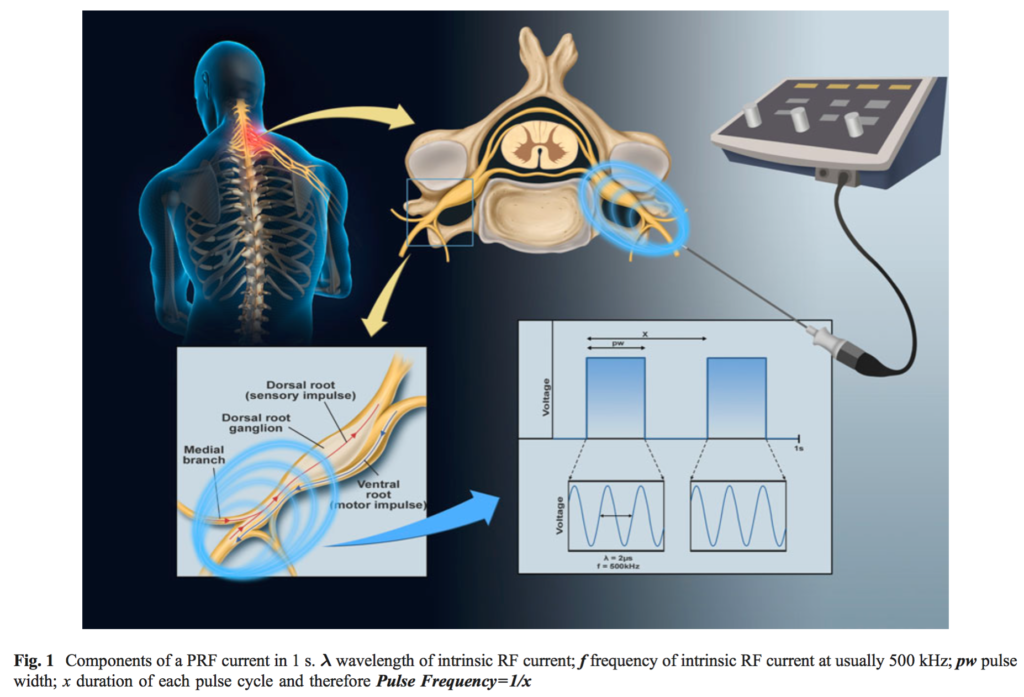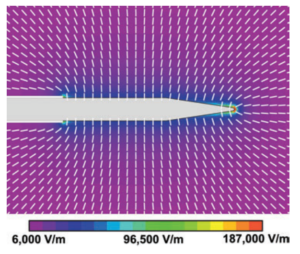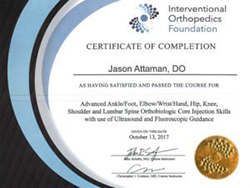
Pulsed Radiofrequency Treatment (PRF) refers to the process of delivering a small current in brief bursts via an electrode sheathed in a hollow needle. This is done after the needle has been inserted through the skin and aligned with an affected nerve in the body. Research shows that PRF alters the way nerves function. The bursts of current “reset” the nerve to alter transmission of pain signals, therefore reducing pain. Resetting the nerve does not damage the nerve or cause worrying side effects. This is known as “neuromodulation.” Neuromodulation selectively changes the part of the nerve that is responsible for pain signaling.
PRF is aptly named because there are ‘silent phases’ in between current bursts, where heat is allowed to dissipate and the area cools down. This prevents the nerve and surrounding tissue from overheating past 40°C – the temperature threshold for causing damage.

An illustration of the direction and distribution of the electric field. The color intensity scale demonstrates the voltage reading along the electrode tip.
Why It’s A Great Option
PRF is a novel treatment modality that is nondestructive unlike Continuous Radiofrequency (CRF) treatment. CRF uses much higher temperatures and continuous current to intentionally destroy nerves and tissue to reduce pain. Dr. Attaman offers both PRF and CRF for his patients, and depending on the nerve involved or the pain issue, sometimes one is better than the other.
Because it is nondestructive, PRF can be used to treat nerves that serve important functions in the body without damaging them.
PRF comes with less side effects compared to CRF. It is also known to work for different kinds of pain, not just nerve pain (known as ‘neuropathic’ pain). The pulsed delivery of current and minimal heat greatly reduces the risk of damage to the nerve and surrounding healthy tissue. The important part is you can still get very good pain relief (as many of Dr. Attaman’s patients do) with the pulsed delivery and lower temperature. Duration of pain relief can vary from patient to patient, with the range being 6-12 months and sometimes longer.
Overall, PRF is an viable and appealing option for people who are experiencing pain that is not well managed by a conservative regimen. A conservative regimen includes therapies such as nerve blocks with local anesthetic and/or steroid, medications, physical therapy, etc.
If you have tried different nerve pain treatments without success, PRF could be the solution for you. It is a state-of-the-art therapy that has the potential to give you the pain relief you have been waiting for.
The Procedure
This procedure itself (without considering time to check in and be prepared), takes 30-45min and is done on an outpatient basis, meaning you do not have to stay overnight. The amount of procedure time varies depending on the number of target nerves and their anatomic locations. You may choose to have light sedation administered intravenously (through IV) that will help you relax and reduce any associated pain during the procedure. It is important to note that if you opt to have any type of sedation, you will be required to have a driver over 18 years old to take you home.
You will be prepared for the procedure by our highly trained staff. After you are in the procedure room, Dr. Attaman starts the process by injecting local anesthetic to the area of skin where he plans to insert the treatment needle and electrode (the needle itself is very small). This will numb the skin for comfort. He will then use fluoroscopy (x-ray) or ultrasound to meticulously guide his needle placement as close as possible to the target nerve. After confirming the needle’s location, he will insert the even smaller electrode into the hollow needle and begin delivering PRF to the nerve. Once PRF delivery is completed, he will take out the electrode, take out the needle, and the injection site is cleaned and bandaged. There are no scalpels used for this procedure!
Video Example of the Procedure
Please note that there are differences in the procedure depending on the number and location of the nerves. Otherwise, the procedure is minimally invasive and image guided with x-rays or ultrasound waves.
Set Up A Consultation
An initial consultation is very important. Dr. Attaman is always happy to consult with new and returning patients to help them learn more about PRF treatment. It is very important that he gets to hear your story and consider all treatment options before deciding if PRF is right for you. With that being said, Dr. Attaman and his staff welcome your questions and concerns.
PRF is not the ideal solution for all situations. If there are better or longer lasting treatment options, Dr. Attaman will offer those to you.
FAQ
1. Does pulsed radiofrequency treatment hurt?
Since there are injections and some needle manipulation involved to properly target the nerve, you can expect some mild pain. However, Dr. Attaman is a highly trained physician and is highly experienced with injections, so he feels very comfortable performing this procedure. As mentioned earlier, there is the option of receiving sedation if you feel that local anesthesia (skin numbing) is not enough for you. Dr. Attaman and his team are here to make you feel as comfortable as possible.
2. When will PRF start to take effect?
The numbing effect of the local anesthetic will wear off in the hours following the procedure. Relief from the PRF treatment itself will build up gradually to its full effect and this may take up to a few weeks. The onset is subtle and will progress as time goes on. There are no guarantees with any medical treatment, and results will vary.

Good idea Dr.Attaman. I have been using L2 pulsed DRG to treat lower lumbar discogenic pain with reasonable success. As you know, L2 DRG is the relay station for all the sensory nerves for the discs.
Dr. Attaman,
I appreciate your constant investigation and accrual of the newest techniques for pain control.
I am a physician and professor at Sidney Kimmel medical college in Philadelphia. I have suffered from ophthalmic post-herpetic neuralgia for the last 18 months. Following many therapies including spinal sympathetic blocks (2), PENS (6), pulsed Transcranial Magnetic Stimulation (17), HBOT (19), steroids injections, and Botox, I have been convinced for some time that my treatment should be pRF, particularly at the higher voltages (~65volts), directly into the supra-orbital foramen.
It was unfortunate that I was unable to recognize and apply many therapies earlier, but I was so impacted by the infectioin, it took over 5 months before that was possible, closing most of the windows for earlier treatment.
If you may consider this treatment in my case, please establish a dialog, but I understand if I do not hear from you.